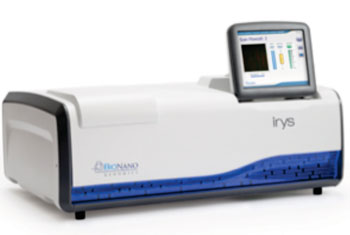Hybrid Gene Mapping Approach Yields Reference Quality Results
By LabMedica International staff writers
Posted on 16 Jul 2015
A team of genomics researchers from the USA and Europe have developed a new approach for describing nearly complete genomes by combining high-throughput DNA sequencing with genome mapping techniques.Posted on 16 Jul 2015
Conventional next-generation sequencing (NGS) techniques are able to accurately detect certain types of variation, such as single nucleotide variants and small insertions or deletions, but miss many large or complex forms of genomic variation that are associated with human disease.

Image: The automated, benchtop Irys instrument enables the genomic researcher to acquire high-resolution, multi-color images and conduct single-molecule analysis of long DNA molecules (Photo courtesy of BioNano Genomics).
To overcome the inherent limitations of existing NGS methods, investigators at the Icahn School of Medicine at Mount Sinai (New York, NY, USA), several other American research institutions, and the European Molecular Biology Laboratory (Hamburg, Germany) combined two single molecule approaches. These were the long read sequencing method from Pacific Biosciences (Menlo Park, CA, USA) and Nanochannel Array and Irys reader technology from BioNano Genomics (San Diego, CA, USA). Pacific Biosciences sequencing enables reads exceeding 10 kilobases in length, which can directly resolve and phase complex forms of variation. The NanoChannel Array method confines and linearizes DNA molecules up to megabases in length to provide high-resolution genome maps.
The two techniques were combined into a hybrid approach that was used to analyze the NA12878 diploid genome, a well-sequenced specimen that is included in the 1000 Genomes project and is often used for benchmarking new techniques.
The investigators reported in the June 29, 2015, online edition of the journal Nature Methods that the hybrid assembly method markedly improved upon the contiguity observed from traditional shotgun sequencing approaches. They were able to identify complex structural variants (SVs) missed by other high-throughput approaches. In addition, they phased both single-nucleotide variants and SVs, generating haplotypes with over 99% consistency with previous trio-based studies.
“We created a high-throughput strategy that builds highly contiguous de novo genomes without the need for complex jumping libraries or targeted approaches. This strategy, in some cases, automatically resolved complete arms of chromosomes,” said senior author Dr. Ali Bashir, assistant professor of genetics and genomics at the Icahn School of Medicine. “While we focused this study on a human genome, the method can be applied to any new genome, including those with high genomic complexity, such as plants, that have been extremely challenging to study.”
“The study revealed an unprecedented view of genomic complexity, in many cases identifying regions overlooked by conventional sequencing or further refining previously known genetic variant classes,” said contributing author Dr. Jan Korbel, group leader at the European Molecular Biology Laboratory.
Related Links:
Icahn School of Medicine at Mount Sinai
European Molecular Biology Laboratory
BioNano Genomics













